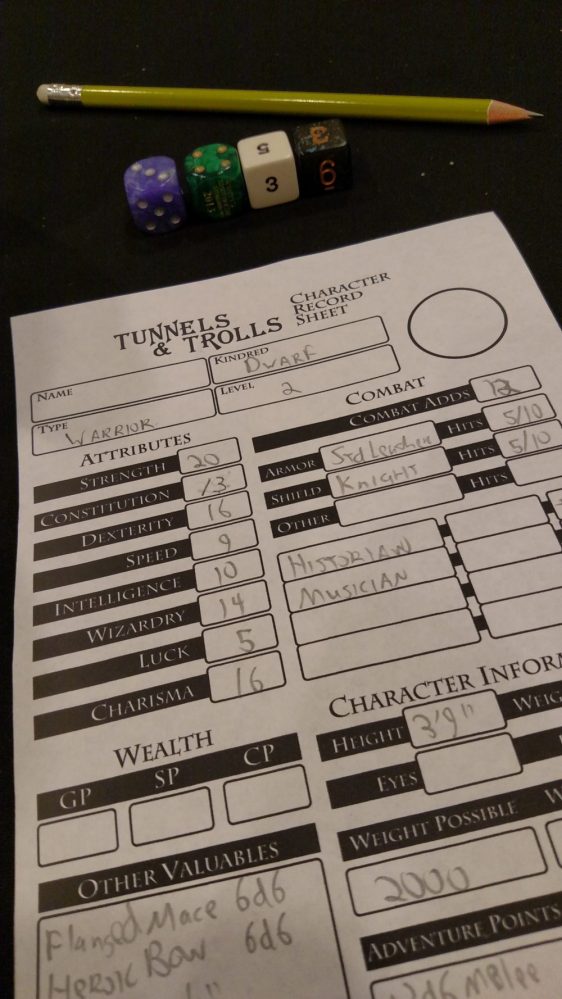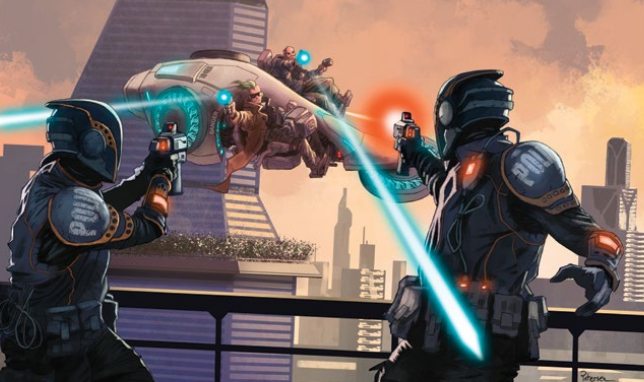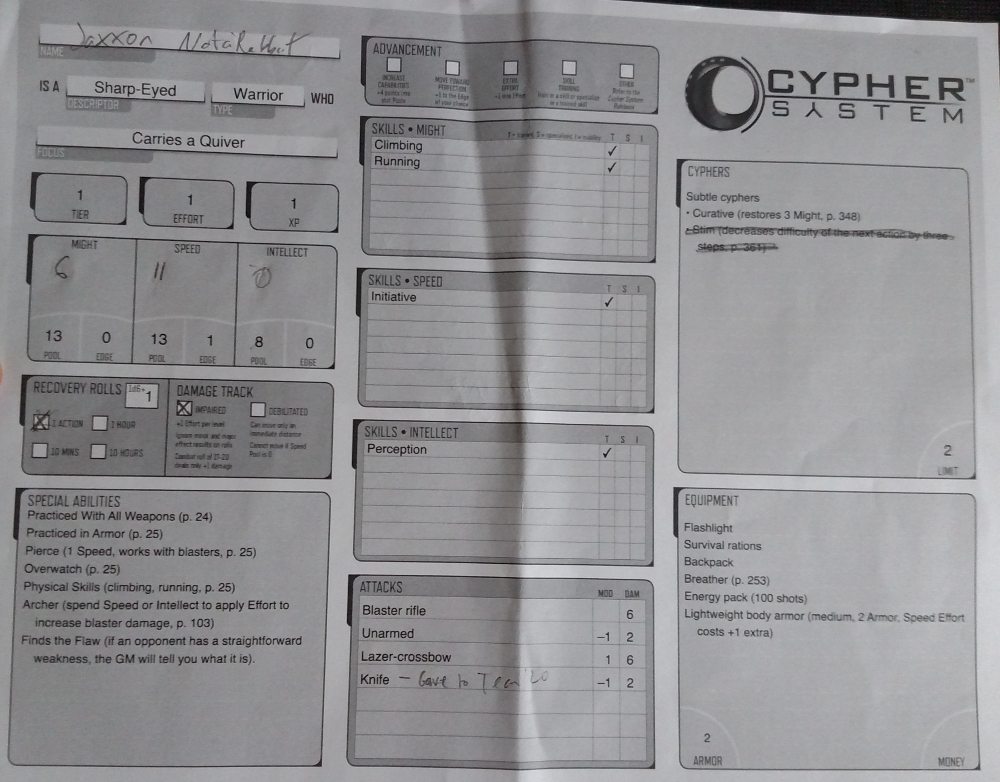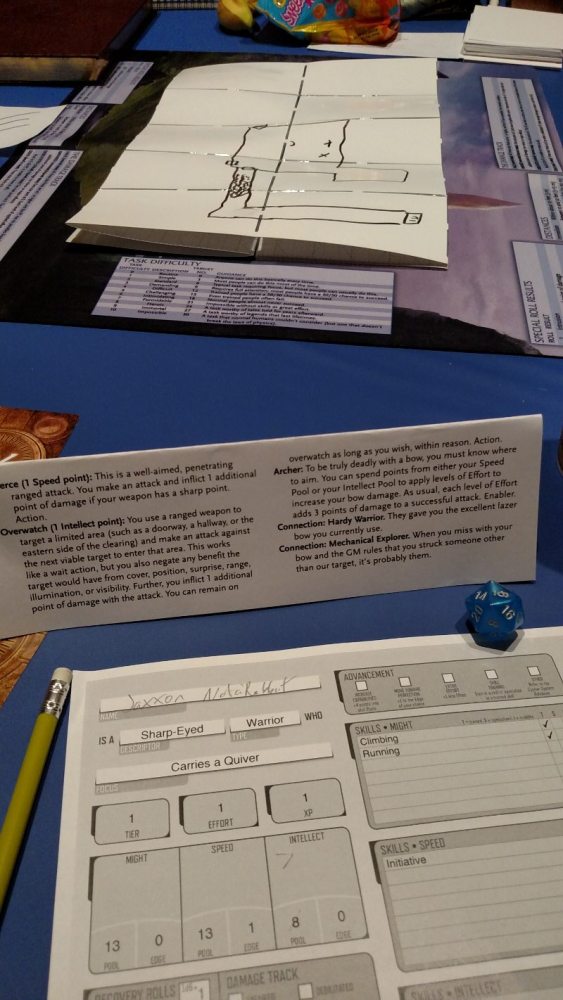One of my favorite things about Gen Con is sitting down for some role-playing games. It doesn’t matter whether it’s a ticketed event, a chunk of time scheduled with friends in an open-gaming area, a table mostly of people I already know, or five fellow attendees I’ve never met before.
I aim each year to add something different to the mix, and my first RPG at Gen Con 2016 was a wholly new experience for me: A Tunnels & Trolls adventure called “Dungeon of the Baar,” with the most classic of gaming storylines: “The characters need to loot & escape.” (Technically, we were playing the new Deluxe Tunnels & Trolls rules – but as I’d never played the game, I can’t tell you what exactly that “deluxe” means.)

I knew going in that Flying Buffalo’s Tunnels & Trolls (which just marked its 40th year at Gen Con) is known for its lighter, more humorous take on fantasy, and that the game system was originally designed in 1975 to offer a simpler, more story-driven approach to play, as opposed to the wargaming-inspired combat rules of early Dungeons & Dragons. And that’s about all I took into the session with me: I wanted to learn something new and have fun, and the session succeeded on both counts.
Within a few turns, one of the characters had turned into a… wombat, I think? Or a badger? (Eventually, she became a bear – I don’t think she ever made it back to her original gnome form.) There were carnivorous fungi and meta-settings referencing Gen Con’s real-life True Dungeon, and it was a lot of fun.
If you’ve never played Tunnels & Trolls, here are a few basics:
Although we used pre-generated characters, our GM explained the creation process briefly, and it seemed straightforward enough – you roll three six-sided dice (T&T almost exclusively uses six-siders – which also reflects designer Ken St. Andre’s desire to keep it simple and accessible), and assign the total to one of eight attributes: strength, constitution, dexterity, speed, intelligence, wizardry, luck, and charisma. If you roll a triple, you roll again, and add the new total to your original mark. Attributes are also not set in stone, and will rise and fall during game play. (Particularly Constitution, which is essentially the Tunnels & Trolls equivalent of hit points.)

Attribute scores are used when you’re attempting an action using what’s called a Saving Roll: You roll 2D6, and add the result to your attribute score to see whether you’ve surpassed the target number needed to succeed. Roll doubles, and you add those to your total, roll and add again. Target numbers are based on the level of difficulty of an action: Saving Roll Level 1 requires a 20 to succeed, with higher levels increasing in increments of five. That’s the game’s core mechanic when it comes to actions.
Combat is similarly simplified: Everyone in the party rolls their weapon dice (in the case of my warrior dwarf’s flanged mace, 6D6) and adds in their character’s “Combat Adds” – in my case, 12. Then you take the party’s total and compare it to the foe’s similarly-rolled total. Higher number wins, and the difference between the two is the damage taken. There are a added wrinkles accounting for armor and the like, but that’s basically it.
I played a three-foot-nine, 340-pound dwarf warrior who was also a historian and musician. (And I wish I’d played up those last two a bit more.)
One example of the game’s flexibility: We all had “backpack” listed among our equipment. As the GM explained, we could basically pull anything out of there that our character could reasonably be assumed to be carrying. So, if I’d needed a tuning fork or a reference guide to deceased kings, my dwarf warrior/historian/musician would likely have had one handy.
I really enjoyed our game, and it seems like Tunnels & Trolls would be fun to run, provided you’ve got a group that really likes exercising their storytelling muscles, and is less concerned about dovetailing details with modified die rolls.

Tunnels & Trolls is also known as the first RPG to publish solo adventures, with more than two dozen created over the years. I came home with a short, Gen Con-exclusive giveaway adventure, “Grimtina’s Guard.” The Tunnels & Trolls approach to single-player gaming combines Choose Your Own Adventure-style decision-making with die rolling to determine action and combat outcomes. You can create your own characters, or play with a pre-generated role. Playing through “Grimtina’s Guard,” although I initially wished for a little bit more character-driven choices (something like, “you can try a Speed Saving Roll to run away, or try to parry with a Strength Saving Roll”), the combat encounters within the story required enough pencil-and-paper stat-tracking that it wound up feeling more like an enjoyable, light RPG session than simply reading a book with forking paths through the storyline. (Flying Buffalo also recently announced a digital solo version of its 1977 solo adventure “Naked Doom,” built on an upcoming adventure publishing platform called MetaArcade. Playthroughs were available at Gen Con, and James Floyd Kelly and I both gave it a shot. More on this in an upcoming post.)

For a third straight Gen Con, I signed on for a Monte Cook Games RPG session. This time around, it was “Assault on Singularity Base,” a stand-alone science-fiction adventure built using the Cypher System, developed from the game mechanics behind Numenera and The Strange. Those games share a similar otherworldliness in their settings and characters, but I wanted to see how the Cypher System worked in a more straightforward universe of storytelling – in this case, one inspired by a certain classic cinematic sci-fi/space opera.
Cypher System characters are still shaped by filling in the blanks of the sentence “I am a (Descriptor) (Type) who (Focus).” I took on the role of a Sharp-Eyed Warrior who Carries a Quiver, and named my character Jaxxon Nota’Rabbit. Useful one-shot items are still called “cyphers,” but aren’t necessarily the mind-bending oddities they are in Numenera and The Strange. Mine included a curative (think health potion), and a stim (to decrease the difficulty of my next action). Since it’s designed to be used across range of genres, the Cypher System significantly expands the range of descriptors, character types, and foci available to players. And while the character stats are determined and utilized in the same way as those other games, the Cypher System character sheet organizes the information in a generally more usable and accessible way – which is fitting, since it’s meant to feel right in any setting you’d like.

There were six tables in our session, which began with a full-group gathering that served as a Mission Briefing: Everyone learned what the other tables’ objectives were, from breaking into an Imperium detention block and rescuing prisoners (our goal), to creating a distraction that would make other teams’ tasks a bit easier by attracting enemy troopers. Although each table played independently, there was a neat level of interaction as the GMs would send messages back and forth to each other with information on progress updates, alarms activated, and combat reinforcements. Occasionally, a player would switch tables to help out another squad. The only place this fell apart a bit was at the end, when our group reached the escape shuttles to find a battle in progress – it was tough to bring our entire party smoothly into the fray with the team securing the landing platform, and things got a bit chaotic, but we were having so much fun with the story unfolding that it wasn’t a game-breaker. Also, it would have been neat to have a short collective de-briefing, so we could all hear how the other teams did, and how their actions affected everyone else.
I continue to enjoy the Cypher System character-building and game mechanics, which can seem odd to first-time players, but which I think ultimately do a great job of balancing story and character with rules that still allow for creative storytelling, surprises, and a logical element of chance when it comes to success and failure. If you’re into serious worldbuilding and creating RPG adventures from the ground up in whatever setting you feel like, the Cypher System might be the tool kit you’re looking for. You can check out a preview PDF for free at the Monte Cook Games website.
Unfortunately, I didn’t get to try a third new RPG this year, since my session of Colonial Gothic: The Strange Case of the Palmer House was cancelled shortly before Gen Con. I’d really like to try this supernatural/horror game set during the dawn of the American Revolution, so I hope there’s another chance next summer.
Dungeons & Dragons was back on my agenda this year, too. I played a four-hour Fifth Edition session with James Floyd Kelly and our friends Paul, Wendy, and Brian, along with another player who was assigned to fill out our table. “A Scream in the Night” was a murder mystery that served as part one of a trilogy of Gen Con adventures set in Melvaunt, the City of a Thousand Forges. It involved some nifty puzzle-solving and a pretty cool villain reveal in the final stage, and if the full trilogy eventually sees release as a complete short adventure, I’d probably pick it up.
The one thing I didn’t accomplish at this year’s Gen Con, RPG-wise, was play in a custom game with friends. The past three years, those have included sessions of Firefly, Gamma World, and Numenera (which I actually ran last year in my first time as a GM), and they are among my favorite Gen Con memories. This year, between the RPGs I opted to play and a few other new events, I feel like I bumped right up against my limit in terms of over-scheduling myself, even with my Colonial Gothic cancellation: My Thursday and Friday at the con were packed, and poof! – suddenly it was Saturday. Next year, my goal is to plan ahead with friends and get an RPG session coordinated before the Gen Con event schedule actually comes out, so that we can work around it instead of trying to squeeze it in after the fact.




